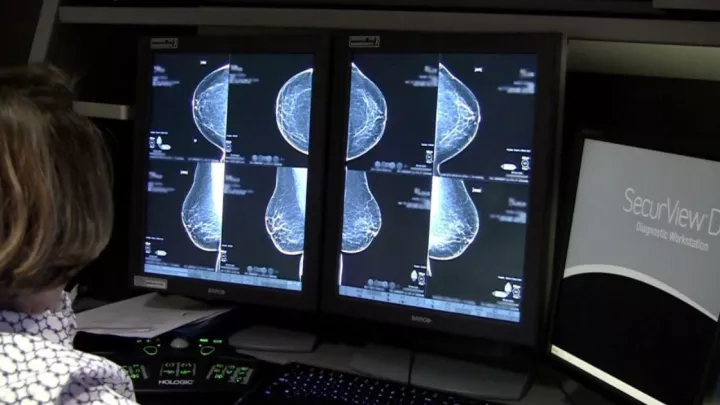Called back after a mammogram? Here's what to expect

Finding out you need more tests after a mammogram can be unnerving. Approximately 10% to 12% are asked to come back for various reasons. Still, the good news is that fewer than 1 in 10 test positive for cancer after a second appointment.
Nebraska Medicine provides 3D (tomosynthesis) mammograms, which find more cancers, and decreases callbacks, to every patient. But if you need additional testing, it's most likely because:
- There may be something new or different compared to prior years
- A first mammogram offers a baseline for doctors. If we don't have prior imaging to compare your results, we may need more tests to determine if what we are seeing is normal for you
- The imaging was hard to interpret due to positioning or other variables, so we need more testing to get adequate pictures (referred to as a technical repeat)
What to expect when more testing is needed
What comes next depends on what the radiologist sees. You may be called back for a diagnostic mammogram or an ultrasound. At times, a patient may need both for clarification.
- A special, diagnostic mammogram focuses on the area the radiologist needs more information on
- An ultrasound focuses on a specific area to see if there is something concerning or not worrisome (like a benign mass)
- If you need a technical repeat, the technologist will redo the mammogram to get clearer pictures
If a radiologist decides that everything looks normal or that the finding is definitively benign, expect to go back to your regular yearly screening mammogram. If the radiologist is confident that the results are most likely benign but can't be 100% sure, they may ask you to come back for follow-up imaging (three months or six months).
What to keep in mind while you wait for results
It's helpful to remember that only 1 in 10 callbacks result in something worrisome. Still, waiting can understandably cause some anxiety. Try to stay calm and do all the things that have been helpful with stress in the past. Talk with a friend, spend time with family, exercise, meditate or choose activities that occupy your mind and bring enjoyment.
"We hate calling people back after a mammogram because we know it can be scary," says Becky DeVries, DO, Nebraska Medicine radiologist. "But we would rather be safe by calling you back even if we suspect it may be nothing to worry about. You are being proactive with your health by coming in to get your screening mammogram, so we want to do right by you."
Remember that there are numerous, less worrisome things a call back could mean other than cancer.
Radiologists see these types of results often. For example, it could be normal breast tissue that overlapped differently compared to prior years or something benign (such as cysts, fibroadenomas, fat necrosis, breast lymph nodes, or other common results).
If you have dense breast tissue or are at increased risk for breast cancer
If your breast tissue is dense but your calculated lifetime cancer risk is under 20%, your insurance may cover a screening breast ultrasound. This type of ultrasound looks for things that a mammogram may not see because your dense breast tissue hides them. If your calculated lifetime cancer risk is over 20%, your insurance may cover a screening breast MRI.
The Nebraska Medicine Cancer Risk and Prevention Clinic can help if you are at increased risk for breast cancer. It offers personalized risk assessments, strategies to reduce your risk, and recommendations for proactive screening.
Screening recommendations for early detection
Early detection saves lives, so don't let fear keep you from regular screenings and follow-up appointments. For everyone, a good rule of thumb is if you feel something strange or new, talk with your doctor.
Biological females
Breast radiologists and surgeons recommend an annual mammogram starting at 40 or sooner if you are considered high risk. "We see breast cancer in women in their 40s not infrequently, and this is a time when potentially you are running your household, are deep into your profession, or both," says Dr. DeVries. "Catching cancers early before they are clinically evident and spread to other parts of your body makes them easier to treat and increases survival rates."
Men, trans females and males and nonbinary patients
- Although breast cancer in biological men is rare, it is still possible
- If you have Klinefelter syndrome or another known genetic mutation that puts you at risk for breast cancer, talk to your doctor about screening mammogram
- If you are a trans male and have not had top surgery, consider a yearly screening mammogram if you are 40 or over
- If you are a trans female and have been on hormones for at least five years, or have other high-risk factors, talk to your doctor about annual screening
- If you identify as nonbinary but are a biological female, have breasts, and are 40 or over, schedule a yearly mammogram
"I love my role as a breast imager because patients are proactive and conscientious about their health," says Dr. DeVries. "As radiologists, they make us want to do our best to save as many lives as possible by finding cancers when they are tiny. Patients diagnosed with breast cancer are fighters, and we at Nebraska Medicine work as a team to beat cancer every day."







